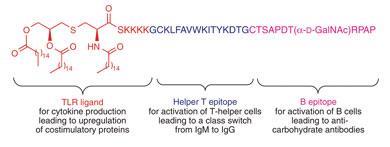Synthetic cancer vaccine targets sugar molecules on the surface of tumour cells
A promising new ’slimline’ cancer vaccine that triggers a powerful immune response against excessive sugar molecules has been unveiled by researchers in the US. The vaccine, which combines three active ingredients into the same compound, has already shown early promise in generating anti-cancer antibodies in mice.
Vaccines work by training the body’s immune system to recognise a rogue invader by presenting deactivated examples of the harmful substance. Since many types of cancer cells have excessive quantities of specific carbohydrates on their outer surface, it should be possible to teach the immune system to recognise these carbohydrates as harmful using some form of vaccination.
However, it has proved difficult so far to develop vaccines based on these carbohydrates. The carbohydrate molecules need to be attached to a carrier molecule - usually a large protein - by a linker, such as a peptide. However, previous research has found that the immune system tends to latch on to the protein and the linker and ignore the carbohydrate.
Now, Geert-Jan Boons and his team at the Complex Carbohydrate Research Centre at the University of Georgia in the US have constructed an entirely synthetic vaccine without the need for bulky proteins.
Using a technique called native chemical ligation, Boons’ team constructed a range of vaccines containing three essential components, each designed to stimulate a specific part of the complex immune system: a carbohydrate, a peptide and a lipoprotein that increases the potency of the vaccine, ensuring a powerful immune response.

’Our chemical synthesis technique allowed us to test a good number of different compounds to arrive at the most efficient vaccine,’ Boons told Chemistry World. ’Interestingly, the three elements of the system need to be covalently linked into one molecule. If you add them separately you do not get a response. Furthermore the architecture of the molecule is significant - the three components must be arranged in a particular way.’
When injected into mice, the vaccine provoked the production of large quantities of anti-carbohydrate antibodies. The antibodies were isolated, and found to kill cancer cells in the test tube very efficiently. ’The next step is to see if the vaccine can cure cancer in an experimental animal,’ Boons said.
Anthea Martin, of Cancer Research UK, told Chemistry World that the field of cancer vaccines was ’evolving, and very exciting.’ She said that while Boons’s vaccine had induced an immune response to cancer cells with a particular type of carbohydrate, ’it’s too early to say whether it could ever be a treatment for the disease.’
Simon Hadlington
References
S Ingale et al., Nat. Chem. Biol., 2007, DOI: 10.1038/nchembio.2007.25






No comments yet